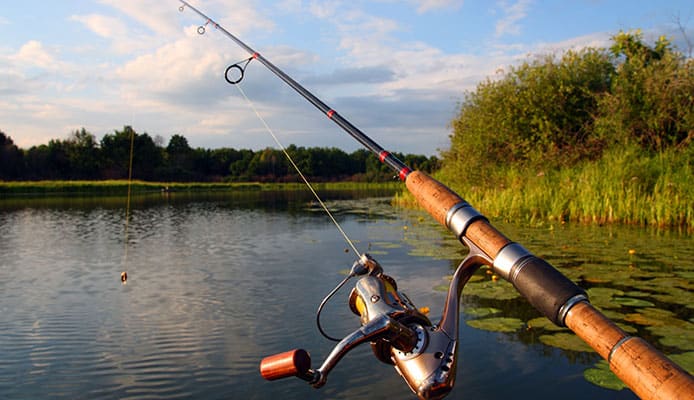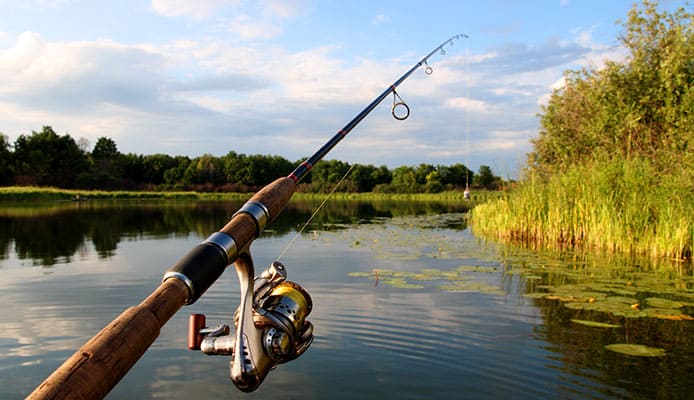
Walking into the shop to buy your very first fishing rod can be a pretty exciting experience, but it can sometimes happen that this feeling immediately turns into a daunting one once you see the myriad of fishing rods available on display. This is especially true if you haven’t done enough research on how to buy a fishing rod before this. However, choosing the right fishing rod need not be all that complicated. Here we give you a brief and concise outline of what you need to learn about fishing rods and how to buy a fishing pole for yourself.
Types of Fishing Rods
If you do your search online, you will see that there are many different types of fishing rods available for sale. However, fishing rods (whether freshwater or saltwater fishing rods) generally fall under the following categories.
- Spinning Rods. Spinning rods (and spinning tackles in general) are very popular among many anglers because they are easier to use compared to other types of fishing rods. Their ease of use allows anglers to cast further with light lures and thus allow them to cover more water. Aside from that, these rods are also relatively inexpensive and well within the budget of most anglers.
- Compared to spinning rods, baitcasting rods are more difficult to use, especially for those who are just starting to learn how to fish. However, they do come with several advantages that make them appealing to many professional anglers. For instance, baitcasting tackles allow for more accurate casts and can handle heavier fishing lines.
- Spin-casting. Spin-casting rods are pretty similar to baitcasting rod, so much so that they are both mostly identified nowadays as simply ‘casting rods’. Because of their similarities, it is possible to use either type of reel (baitcasting reel or spin-cast reel) on either type of fishing rod (though some models and designs may not readily allow for such exchange).
- Fly Fishing Rods. Fly fishing rods are specifically designed for fly fishing, and though it may look like a regular fishing rod, it has certain features that distinguish it from one. A fly fishing rod is typically very thin and lightweight and has very small guides. The reel is also located below the handle. Because fly fishing rods rely on the line for the casting weight, fly fishing enthusiasts use a thicker fishing line to cast long distances.
- Telescoping Fishing Rods. Telescoping fishing rods (also referred to as collapsible or folding fishing rods) are composed of several pieces. When in use, each rod blank slips out of each until they are fully extended. After using them, the rod pieces are then slipped back accordingly. Because of their compact size, they are much easier to travel with than a full-length single piece fishing rod.
There are plenty of other types of fishing rods available in the market, but the ones above are generally what you would see being sold in shops all over the world.
Fishing Rod Materials
Fishing rods today are made from a variety of materials, namely fiberglass, graphite, or composite mix. Each of these materials has its own pros and cons, and understanding the differences between them need not be that hard at all.
- Fishing rods made from graphite-like some jerkbait fishing rods are typically lighter and stiffer. These features allow the fishing rod to be more sensitive which is great for detecting subtle bites. Besides, they are considered more powerful when it comes to lifting heavy fish out of the water. However, graphite fishing rods aren’t as durable as their fiberglass counterparts and are more likely to break.
- Fiberglass like those used in the making of some jigging fishing rods are tough materials, but they’re also the least sensitive and least powerful. However, fishing rods made from this material are generally more affordable.
- Some fishing rods like drop shot fishing rods and others are made from composite materials or those that incorporate a mix of fiberglass, graphite, and other materials. That said, composites often carry the advantages and disadvantages of both materials. For instance, they generally cost more than fiberglass fishing rods but are more affordable than graphite ones. Then again, the combination of these materials results in a fishing rod with excellent sensitivity, strength, and durability.
Rod Handle
The rod handle is generally made from cork, foam, or a combination of both materials. Some manufacturers even come up with their own types of grips for their rod handles like cord, shrink wraps, and others. Nonetheless, the following are the most common types of rod handles that you’ll see.
- Cork gives fishing rods a classic and stylish look and is generally seen in most freshwater and inshore fishing rods. They’re also pretty lightweight and can be sanded to create a more ergonomic grip.
- Foam rod handles are more comfortable according to some anglers. However, unlike regular foams, these are denser and more durable. They also have a very little stretch.
- These handles are generally made from Hypalon and are extremely durable and can withstand abuse much better, making them suitable for anglers who lock their fishing rod in rod holders while trolling.
Truth be told, the choice of rod handles are generally based on personal preference, and one is not necessarily better than the other. That said, you’ll want to try out several rod handles and feel which one feels more comfortable for you before committing to one.
Rod Handle Lengths
Rod handles like fishing rods are also available in short and long versions, each of which provides certain advantages and disadvantages to anglers.
- Short rod handles can generally only accommodate a single hand, which makes them great for casting with one hand or casting in a short distance.
- Long rod handles on the other hand can accommodate two hands and thus allow the angler to exert more power when casting the rod, thereby making it go further.
You might also like: How To Cast A Spinning Rod?
Fishing Rod Length
Fishing rods are available in several lengths, from short 4 feet fishing rods for kids to lengthy 14 feet fishing poles. So, should you go for the short one or the longer one?
- Short fishing rods. Short fishing rods are great for casting too short distances and close-quarters combat. Because of their length, they allow for less bending and stretching, which makes them great for big fish angling. They also make great kayak fishing rods since their size leaves room for their other fishing equipment and tackle boxes.
- Long fishing rods. On the other hand, longer fishing rods are necessary if you’re looking to cast long distances and water to cover more water. Many saltwater anglers and inshore fishermen use longer rods for these reasons.
Rod Power
Rod power describes how much pressure is required to bend the fishing rod and its ability to lift the weight from its tip. Power is categorized as light, medium, and heavy. There are also ultra-light, medium-heavy, and other similar categories. All these though fall somewhere in-between the major three categories mentioned earlier.
- Light fishing rods require less pressure to bend, which means that small fish species like panfish and trout will be heavy enough to make the fishing rod bend. Obviously, these are the fishing rods of choice when angling for small fish.
- Medium power rods provide a balance between the sensitivity of a light power fishing rod and the stiffness of a heavy power fishing rod. This makes them great for fishing with jerk baits, spinnerbaits, and other types of reaction baits.
- Fishing rods with heavy power are stiff and are generally used for surf fishing or when you’re targeting large fish species.
Rod Action
Rod action simply refers to how much the fishing rod bends and how fast it returns to its neutral position and is categorized as either slow, moderate, or fast. There are also other categories like extra-fast, moderate-fast, and others. Perhaps the best way to describe rod action is by looking at where the rod flexes when it is bent.
Slow Action. Slow action rods bend all the way to the handle, so yes they are technically the ‘soft’ ones. That said, they are used exclusively for fishing for bluegills and other small fish species.
Moderate Action. Moderate action rods bend on the top half of the fishing pole. Being somewhere in the middle of the rod action spectrum, moderate action rods are versatile and allow anglers to go after small and relatively large fish species as they offer better casting distance and plenty of hook setting power.
Fast Action. Fast action rods will bend at the top third portion of the fishing pole and will feel stiffer as it has more ‘backbone’. These rods are ideal when fishing for muskies, pikes, and other large fish species.
Reel Seats
Simply put, the reel seat is where the reel is attached to the fishing rod. Most reel seats are pretty standard even across brands and manufacturers. There are some guidelines though that you’ll need to keep in mind when looking at reel seats. This may not be all that important if you buy a fishing rod and reel combo where everything comes as a package, but they do come into play if you choose to buy the rod and reel separately.
- Look for reel seats with a cutout since this allows you to feel the rod blank better.
- Avoid reel seats that don’t have a plastic cushion inside the metal hoods since this rust and stain faster. They can bind up, making it difficult to remove your reel should you feel the need to change it.
- Avoid reel seats with cardboard spacers between the reel seat and the rod since this will dampen vibration and will tear easily when it gets wet.
Globo Surf Overview
Having the right fishing rod can certainly make or break your fishing career. Given that the perfect fishing rod does not automatically mean that you’re going to win every bass fishing tournament or land the biggest fish in the pond (or sea, lake, or wherever you will be fishing), it can still make a huge difference on how successful you’ll be out in the water. There are still plenty of things that need to be considered regarding how to buy a fishing rod or when you buy a fishing pole for you or your loved one, but knowing the basics outlined above can sure make the choosing process much easier and less daunting.


